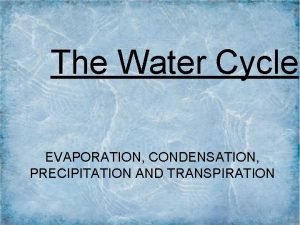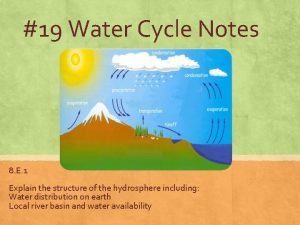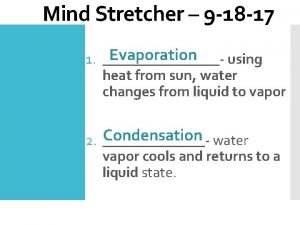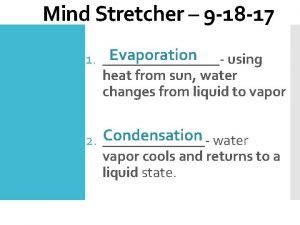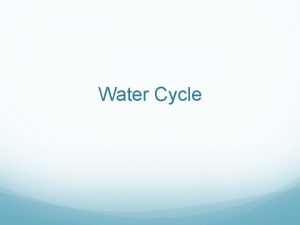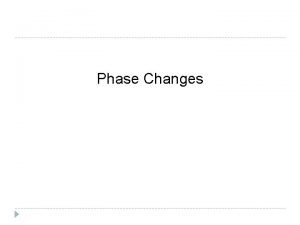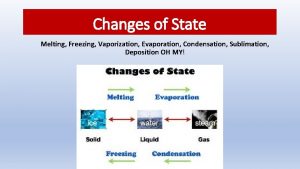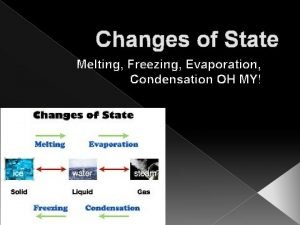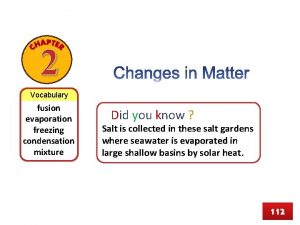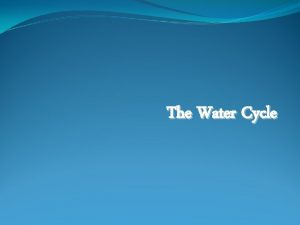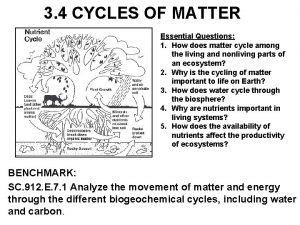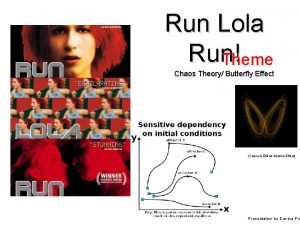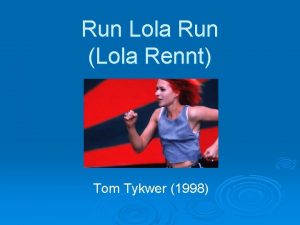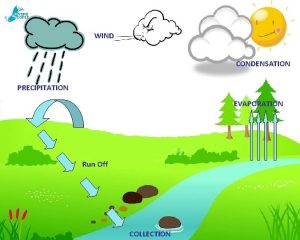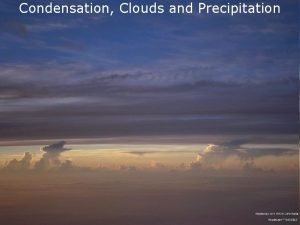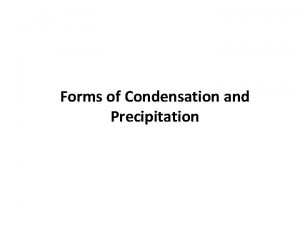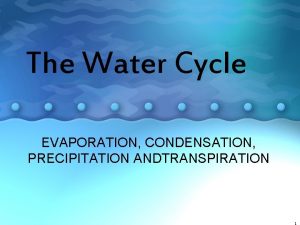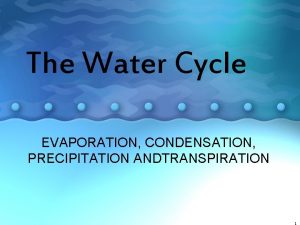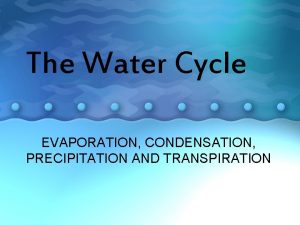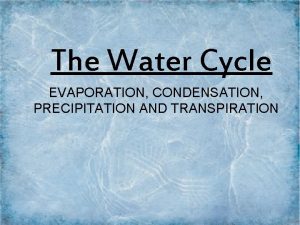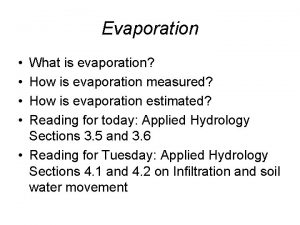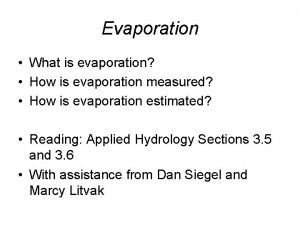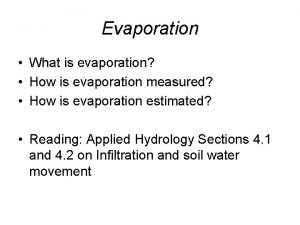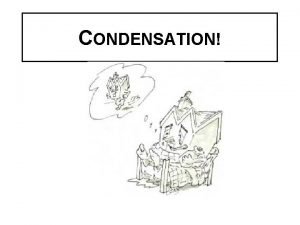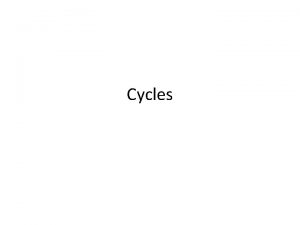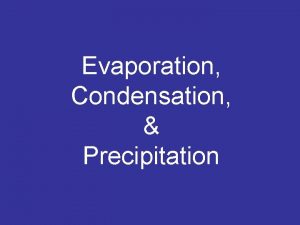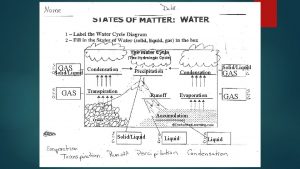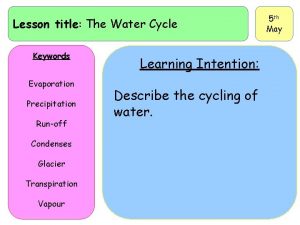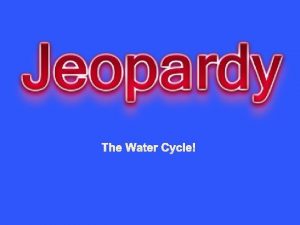Water Cycle Actions Evaporation Condensation Precipitation Run off




















- Slides: 20

Water Cycle Actions: • Evaporation • Condensation • Precipitation • Run off • Infiltration Storage: • Oceans • Lakes • Glaciers • Groundwater

Groundwater Movement • One of the most abundant sources of fresh water on the planet • Motion is controlled by two variables: – Porosity – Permeability

Porosity • Amount of empty space within a material – Material: sediment, fractured rock, sponge, etc • Affected by roundness and sorting of unconsolidated sediments • Expressed as a percent of total volume of substance – Porosity = (volume of pore space)/(total volume) * 100%

Permeability • Ability of water to flow through material – Cohesion, Adhesion? • Affected by pore size and connectedness of spaces • Small pores constrict water flow • Lack of connection between pores reduces/eliminates water flow

Capillary Action • Is the upward motion of ground water • Influenced by particle size – Smaller particles = higher water • Caused by adhesion of water to particles • As pore space gets larger, gravity takes over, pulling the water down • This is why you can dig in the sand near a beach and hit water above the height of the surface of the lake

What is a Budget? • A way to keep track of input/output of a system – Bank account – Water storage • Take the amount coming in, see if you owe anything, pay it, check your balance. If you don’t have enough, then you go into deficit (a la USA, $8, 000, 000).

Lab 25: Local Water Budget • P = Precipitation • Ep = potential evapo-transpiration • DSt = change in storage (same as amt of P-Ep, unless there wasn’t enough in storage from previous month) • Ea = actual evapo-transpiration; why could actual ever be less than potential? • S = surplus, equals (P-Ep)-DSt • D = deficit, the difference between Ea and Ep • St = storage; storage is expressed as a percentage (0 -100)

• When would storage of groundwater be at its maximum? • Start with a month you KNOW will either be full (100 St) or empty (0 St) • Finish this lab so you can use it on the next lab!

Think work 1/28 • Describe a sediment in which water would flow quickly. • Identify the names of all sediment sizes. • What property of sediments allow water to flow upward? • What happens to porosity with increased grain size? • What happens to permeability with increased grain size?

Bell work 1/26 • A region is experiencing a deficit of groundwater and 100 mm of rain falls. There is a potential of 250 mm of evapotranspiration. – How much water evaporates? – How much deficit does the region experience that month? • Monday: using computers to assemble your review sessions! Who still needs to sign up? ?

Climate • The characteristic weather of a region. • Primarily based on temperature (which leads to potential evapotranspiration) and precipitation. – Ratio of P: Ep • Weather is what happens short-term. Climate is the long-term trend of weather.

Other factors affecting climate • • • Latitude (insolation) Location of water and land areas Precipitation patterns Ocean currents Wind belts Vegetation


Climate Classification • Based on moisture, temperature: – Moisture: arid (<. 4), semiarid (. 4 -. 8), subhumid (. 8 -1. 2), humid (>1. 2) • Those numbers are climate ratios – Temperature: polar, subtropical, tropical – Vegetation: desert, grassland (steppe, taiga), deciduous forest & coniferous forest, rain forest • Climate Ratio = P/Ep • Calculate your climate ratios for budget lab

Effect of land/water on temperature • For a given latitude, temperature will vary less with proximity to water; -water has a moderating effect. • Example: San Francisco vs St. Louis Winter: SF=49, SL=32 Summer: SF=64, SL=78

Climographs • Show temperature and precipitation of a region. • Can be used to classify a region’s climate type. – How could you tell if you were in the southern hemisphere?

2/9 1. Norway has an annual precipitation of 1250 mm, and an annual potential evaporation of 1120 mm. Classify Norway in terms of climate zone. 2. What 2 effects do ocean currents have on Norway? 3. Why do large bodies of water have a moderating effect on annual temperature ranges?

What is the effect of ____ on climate? • • • Latitude? Bodies of water? Winds? Ocean circulation? Elevation? Mountains?

• Effect of _____ on climate? • Prevailing Wind patterns – Notice high pressure at 30 degrees? – High pressure = ? ? ? weather • Porosity/Permeability/capillary action – What affects these? – How does water flow faster? – Porosity is independent of particle size! • But what about mixing sizes together? • • Rainfall vs. output (evap, runoff, etc) Factors affecting runoff Reading a water budget (surplus, usage, deficit, recharge) Climate types, ratios

 Condensation evaporation precipitation
Condensation evaporation precipitation Water cycle and transpiration
Water cycle and transpiration Evaporation condensation precipitation on my mind
Evaporation condensation precipitation on my mind Prep 1
Prep 1 Run off water cycle
Run off water cycle Melting freezing evaporation condensation sublimation
Melting freezing evaporation condensation sublimation Is vaporization endo or exothermic
Is vaporization endo or exothermic Condensation particles
Condensation particles Fusion evaporation condensation
Fusion evaporation condensation Evaporation water cycle
Evaporation water cycle Condensation water cycle
Condensation water cycle Steps of gravimetric analysis
Steps of gravimetric analysis Co precipitation and post precipitation
Co precipitation and post precipitation Precipitation in the water cycle
Precipitation in the water cycle Water and water and water water
Water and water and water water Water molecule evaporation
Water molecule evaporation Transpiration is the evaporation of water from
Transpiration is the evaporation of water from Short run and long run equilibrium in perfect competition
Short run and long run equilibrium in perfect competition Run lola run themes
Run lola run themes Run lola run editing techniques
Run lola run editing techniques Short run vs long run economics
Short run vs long run economics
